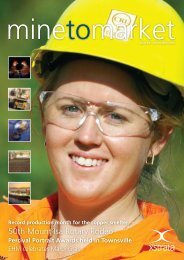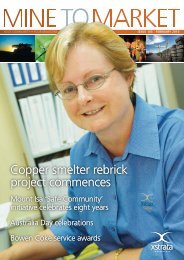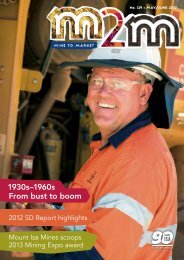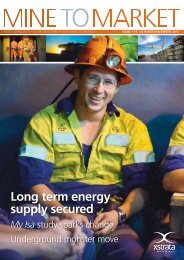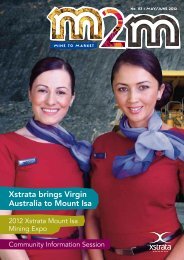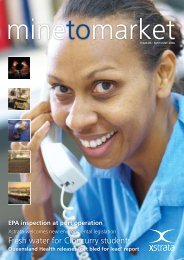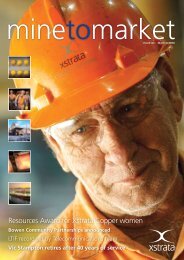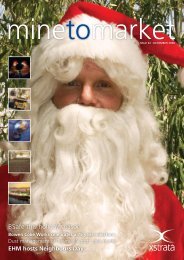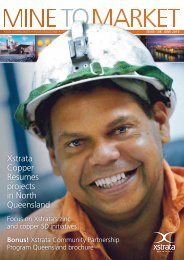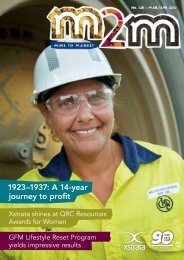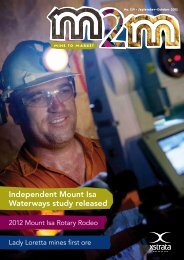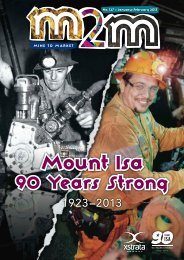Xstrata Copper North Queensland.pdf - Mount Isa Mines
Xstrata Copper North Queensland.pdf - Mount Isa Mines
Xstrata Copper North Queensland.pdf - Mount Isa Mines
You also want an ePaper? Increase the reach of your titles
YUMPU automatically turns print PDFs into web optimized ePapers that Google loves.
Workplace health and safety<br />
We aim to operate a safe workplace that is injury- and fatality-free, and to enhance<br />
the wellbeing of employees, contractors and communities.<br />
Health and safety<br />
We pursue this goal by promoting and<br />
sustaining a culture of safety that seeks to<br />
promote a positive attitude and awareness<br />
of the issues involved. We provide visible<br />
leadership and make our management<br />
accountable for safety performance and for<br />
training employees to improve their safety<br />
knowledge, skills, and to make them aware<br />
that they have a responsibility to themselves,<br />
their family and friends to work and<br />
behave safely.<br />
We detect and eliminate or mitigate<br />
conditions that pose a potential risk to<br />
safety and health in our workplaces and<br />
neighbouring communities. We ensure that<br />
every task undertaken in our operations<br />
has a safe system of work defined and that<br />
our people have tools and equipment that<br />
are fit for the purpose and well maintained<br />
to complete tasks safely and productively.<br />
In addition, through screening programs,<br />
we monitor our employees’ health, wellbeing<br />
and fitness for work.<br />
Injury performance –<br />
<strong>Xstrata</strong> <strong>Copper</strong> <strong>North</strong> <strong>Queensland</strong><br />
<strong>Xstrata</strong> <strong>Copper</strong> uses a risk-management<br />
system to identify, assess and eliminate<br />
or control safety risks. When an unsafe<br />
condition is detected or a safety incident<br />
occurs, it is investigated immediately and the<br />
necessary action is taken to eliminate the<br />
risks involved. Safety auditing takes place<br />
regularly across our business to improve<br />
safety standards, practices and performance.<br />
Safety initiatives and issues are regularly<br />
communicated to all of our people.<br />
Our challenges<br />
Enhancing our risk management strategies<br />
in all aspects of our business was a strategic<br />
initiative in 2010 with three primary<br />
focus areas:<br />
■■<br />
■■<br />
■■<br />
Reduction of high consequence<br />
low probability incidents<br />
Reduction of low consequence<br />
high probability incidents<br />
Health and hygiene.<br />
Disabling injury severity rate † –<br />
<strong>Xstrata</strong> <strong>Copper</strong> <strong>North</strong> <strong>Queensland</strong><br />
To assist in managing these we achieved<br />
99% completion of recording Significant<br />
Risks, Catastrophic Hazards and High Hazard<br />
Activities in our Risk Registers and 83%<br />
completion of Bow-Tie assessments against<br />
these. This process ensures risks are clearly<br />
identified with critical control and task<br />
owners. This data then forms the basis of<br />
monthly and quarterly reporting and our risk<br />
management plans which are reviewed as<br />
part of the annual planning process.<br />
We implemented a series of High Hazard<br />
Activity audit and observation checklists<br />
to monitor workforce behaviour for at-risk<br />
acts and integrated these with enhanced<br />
inspection programs.<br />
Occupational Hygiene Committees were<br />
established at each of our north <strong>Queensland</strong><br />
sites. Committee membership included<br />
representatives from management,<br />
technical experts and the workforce<br />
to ensure a consultative and scientific<br />
approach to the identification, evaluation<br />
and control of hygiene hazards in the<br />
workplace. Hygiene hazard characterisation<br />
studies also commenced in 2010 (refer<br />
Occupational Health section on page 32<br />
for more information).<br />
Number per million hours worked<br />
30<br />
25<br />
20<br />
15<br />
10<br />
5<br />
19.0<br />
16.0<br />
10.0<br />
1.5<br />
0.9<br />
0.7<br />
8.3<br />
0.9<br />
7.4<br />
0.7<br />
Number per million hours worked<br />
300<br />
250<br />
200<br />
150<br />
100<br />
50<br />
107.5<br />
112.6<br />
123.8<br />
138.8<br />
131.8<br />
Safety performance<br />
The <strong>Xstrata</strong> <strong>Copper</strong> <strong>North</strong> <strong>Queensland</strong><br />
Division values the health and safety of our<br />
people. Safety performance is tracked using<br />
the following measures:<br />
■■<br />
■■<br />
■■<br />
Total Recordable Injury Frequency Rate<br />
(TRIFR), which includes all injuries except<br />
first aid treatments<br />
Lost Time Injury Frequency Rate (LTIFR)<br />
Disabling Injury Severity Rate (DISR),<br />
which records the number of days lost<br />
or on restricted duties per million hours<br />
worked.<br />
0<br />
2006 2007 2008 2009 2010<br />
0<br />
2006 2007 2008 2009 2010<br />
TRIFR<br />
LTIFR<br />
† Previously we reported DIFR for 2006. We have now restated to show the DISR results. The Disabling Injury<br />
Frequency Rate (DIFR) measures the number of disabling injuries x 1,000,000 divided by the number of hours<br />
worked, the Disabling Injury Severity Rate (DISR) measures the number of disabling injury days x 1,000,000<br />
divided by the number of hours worked.<br />
Sustainability Report 2010 29



